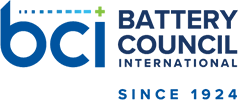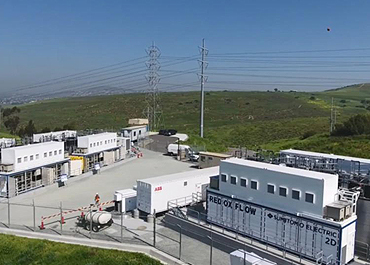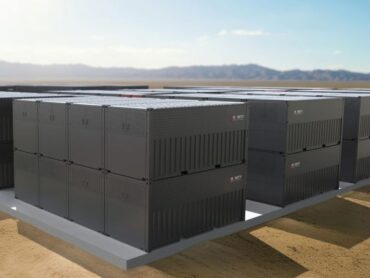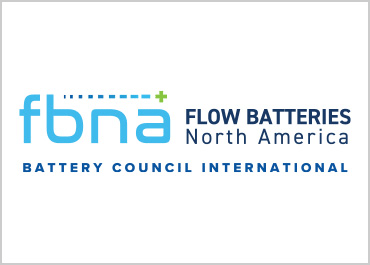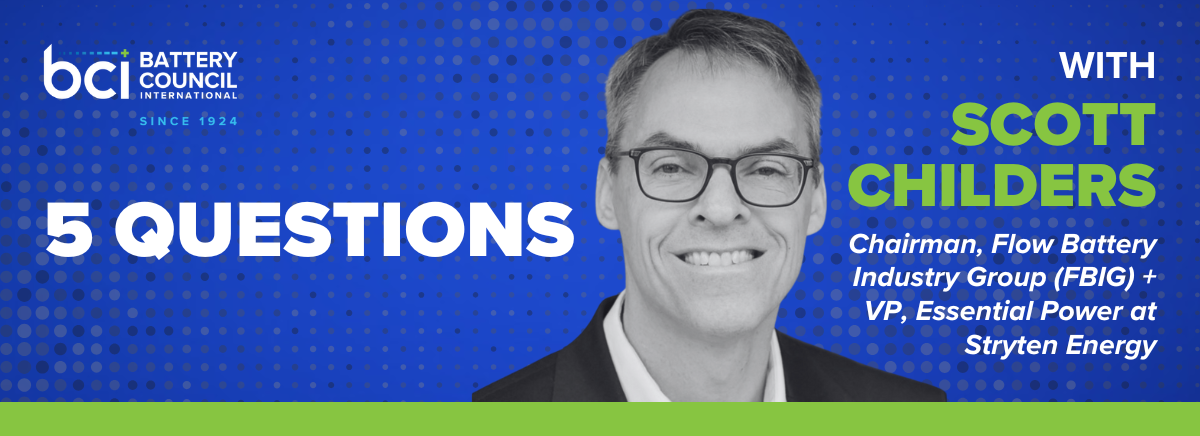
Flow Battery Champions – Meet Scott Childers
Meet Scott Childers, the Vice President of the Essential Power division of Stryten Energy and the chairman of Battery Council International’s Flow Battery Industry Group!
In 2023, Battery Council International formed the Flow Battery Industry Group (FBIG), a collection of leading stakeholders dedicated to technical research and commercialization of flow batteries, with Childers named its first chair.
In 2025, BCI will produce North America’s first ever event dedicated exclusively to this emerging energy storage technology – the Flow Batteries North America (FBNA) conference from Oct. 27 to 29 in Chicago. Childers is co-chair of the organizing committee for FBNA, along with Vincent Sprenkle of Pacific Northwest National Laboratory.
BCI conducted a brief Q&A with Stryten Energy’s Scott Childers to learn more about him, and what he’s working on.

Question #1: Where did you start your career, and how long have you worked in the battery industry?
I started my career with General Motors. Over almost 20 years, they taught me a lot about designing and building fun, high performance products that are first safe, then reliable, all while being affordable for the average citizen. Fuel efficiency was part of almost every design, but I did not have a chance to participate in the larger energy landscape until moving to Hillphoenix in 2014. As a design and manufacturer of refrigeration products, which basically converts electric energy to thermal energy, I was front and center with grid connected energy concerns. I was fortunate enough to meet some old battery guys during my tenure at Hillphoenix, and that’s how I arrived at Stryten in 2021. It’s been equal parts extremely challenging and a thrill of a lifetime where I am responsible for launching three new chemistries into an emerging, and very untamed world of stationary energy storage.
Question #2: How did you get involved with flow battery technology?
Stryten Energy had already initiated interest in acquiring a small vanadium flow battery company from ITN Energy in Denver, CO, when I walked in the door. I was immediately thrust into a full due diligence process, and within weeks, I was standing beside a Vanadium Redox Flow Battery (VRFB) at the SolarTAC test facility near the Denver International airport. It was the perfect challenge, a mature technology that needed a heavy lift to build infrastructure and reduce cost – precisely what both Stryten and I love to do. Unlike the automotive world, there was and there is still little flow battery manufacturing infrastructure or supply in North America. BCI became an interesting nexus to start a subcommittee specifically for maturing this infrastructure. BCI’s deep battery experience and connections to a broad network of battery related partners and supplies in North America has been invaluable.
Question #3: What are some current energy storage challenges that flow batteries are uniquely positioned to solve?
Decoupling power and energy delivery is at the frontier of long-duration energy storage, which then enables wholesale energy trading. No other technology can separate these functions as efficiently as flow batteries. After lithium was developed for personal electronic devices, it raged into every other space from construction power tools, to EVs, to stationary grid-connected storage. As access to lithium increased and volumes drove prices down, it still did not solve the duration issue. For example, in Texas’ ERCOT market, an independent source recently reported that the average duration of all batteries in the system is 1.5 hours. So, the current lithium Battery Energy Storage Systems (BESS) have filled the power quality demands (e.g. frequency matching and voltage support), but now ERCOT anxiously waits for a BESS technology that can provide true wholesale energy trading. Flow batteries with decoupled power and energy and long durations of 4 or more hours are rushing in to fill this gap.
Question #4: What are some innovations or opportunities that make you excited about a bright future for flow batteries?
There is a lot going on with flow batteries, especially if we look across the various chemistry types. Perhaps the most compelling are those innovations that make flow batteries cost competitive with lithium. Due to the long life of a flow battery and the fact that flow batteries do not suffer from capacity degradation due to cycling, flow batteries are almost always have a lower total cost of ownership (often measured as the Levelized Cost of Storage or LCOS). However, now, we are competing on both fronts – first cost to install and LCOS. This is happening in a couple of different ways. First, new organic chemistries are under development which use the most basic and abundant raw materials. These technologies are a little further behind on the commercialization curve, but we are seeing demonstration sites start to emerge. The other area where flow batteries are competing on a first cost basis is process efficiencies. Take Storion’s Vanadium electrolyte production for example. They will be opening a factory this year utilizing their proprietary continuous vs batch electrolyte processing methods. The first factory will be in the Southeast but can be readily duplicated across North America or even at the battery siting location. Again, both processing efficiencies and logistic improvements are now removing first cost barriers for long duration storage. These are incredibly exciting times when we get to watch the energy and grid transformation jump to its next major plateau.
Question #5: What’s one thing someone at a battery company could do to ensure they are a part of the flow batteries success story in the years ahead?
This is not super complicated – setup, make investments, and be part of the transition in North America. This is a mature technology that, up to this point, has been suffering from scale and volume. Other regions in the world are quickly showing the value and ability to commercially and economically deploy long-duration storage leveraging flow batteries. It’s a kind of magic moment right now for flow batteries in North America, where there is room for both first-mover types and fast-followers to jump in various parts of the supply chain. Whether you’re opening a mine, manufacturing pumps, or writing software: set your strategy and focus area, then jump on the wave that’s swelling here in North America. Take advantage of FBNA where you can be connected to customers, financial institutions, academic research, regulators and more to make your launch, strategy, and growth plans possible.
